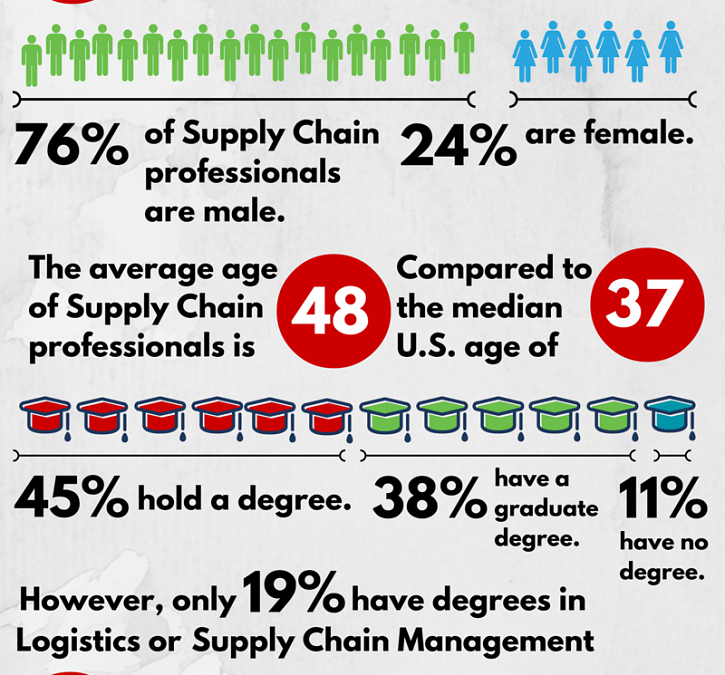
by Jennifer Hart Yim | Aug 24, 2016 | Blog, Manufacturing & Distribution, Strategy, Supply Chain, Talent

The Supply Chain industry is changing, while it’s becoming harder for companies to hire at the same time. These supply chain demographics provide a picture of the industry today.
This guest post comes to us from Argentus Supply Chain Recruiting, a boutique recruitment firm specializing in Supply Chain Management and Procurement.
Everyone knows the Supply Chain field is changing. Recently, one of the best Supply Chain publications out of the U.S., Supply Chain 24/7, released a report that examines the demographic trends underlying the industry. The report, titled “A Portrait of the Supply Chain Manager,” used research survey data from Peerless Research Group and APICS to present a picture of the typical individual working in Supply Chain. The survey asked a number of Supply Chain and talent-related questions, such as:
- What percentage of Supply Chain professionals received a raise last year?
- What percentage of Supply Chain managers hold a degree?
- What percentage of companies are willing to pay above-market compensation for the right people?
And more. These issues are sure to be of interest, whether you’re looking to hire in Supply Chain or just to get a holistic picture of the field. So we put together this spiffy infographic that highlights the answers to these questions and some other interesting datapoints from the report. Check out the infographic below!

We hope you found the supply chain demographics infographic informative, and we encourage you to dig into the full report for even more insights about where Supply Chain professionals stand and where the field is going. And (as always) stay tuned for more info and perspective about Supply Chain and talent from Argentus in the coming days and weeks!
Related posts:

by Fronetics | Aug 23, 2016 | Blog, Content Marketing, Logistics, Marketing, Social Media, Strategy, Supply Chain

TotalTrax leverages content marketing to increase web traffic, generate high-quality leads, and, ultimately, grow business.
TotalTrax, Inc., is a provider of real-time vehicle, driver, and inventory tracking technologies for manufacturing and warehouse operations. Despite a decade of positive growth, the company knew it was missing opportunities for new business because of its lack of a clear digital strategy.
That’s why TotalTrax hired Fronetics Strategic Advisors. The firm created and implemented a multi-channel content marketing program designed to increase the company’s digital footprint and accelerate growth.
Content marketing can help a business elevate its brand position by producing content that demonstrates industry expertise, offers valuable information, and builds trust with their target audience. Example benefits include:
- Increased brand awareness
- Higher referral traffic
- Better lead generation and nurturing
- Improved customer loyalty and trust
- Decreased marketing cost and higher ROI
Fronetics evaluated TotalTrax’s existing digital assets. Leveraging extensive market research, the firm helped refine the company’s messaging and content distribution to better engage potential customers. Fronetics then implemented the customized content marketing strategy to help TotalTrax fully leverage its web presence to bring about new business.
The results
In a 24-month period, TotalTrax realized significant gains in web traffic, quality leads, and brand awareness. Key results included:
- 19% increase in overall web traffic
- 500% increase in traffic from social media
- 244 high-quality leads
- 30% net increase in new customers
To learn more about Fronetics’ strategy for TotalTrax, download the free case study below.

Related posts:

by Elizabeth Hines | Aug 22, 2016 | Blog, Logistics, Manufacturing & Distribution, Strategy, Supply Chain

Improve your company’s financial performance by implementing a risk-management strategy that plans for everyday events and disruptions.
Supply chain disruptions can have a significant impact on business and financial performance. A recent PwC and the MIT Forum for Supply Chain Innovation survey found a strong correlation between the maturity of businesses’ risk-management processes and reduced decline in operational performance indicators in the face of disruption.
A supply chain company’s need for a well-developed risk-management strategy is clear. That means planning for disruptions beyond the big-impact events, like environmental catastrophes, cyber attacks, and geopolitical instability. Companies need to be better prepared to handle day-to-day bumps in the road.
Managing everyday risks
Managers will often consider cataclysmic events but ignore the smaller risks that create friction in the supply chain. Dealing with these smaller factors in a reactive and piecemeal fashion is inefficient and ineffective and can significantly hurt your company.
Consider the following tips when developing an effective risk-management strategy that focuses on the everyday risks:
1) Employ a robust strategy that is always evolving.
Consider all of the factors that currently influence your supply chain, and be vigilant in terms of new technologies or emerging risks that could impact operations in the future.
2) Put a leader in charge.
Choose someone experienced in crisis management, negotiation, and critical problem-solving. This leader should be skilled in diplomacy and remaining calm under pressure.
3) Make sure the strategy is flexible.
A strategy that it uncompromising and rigid can exacerbate issues.
4) Define your comprehensive process.
Develop a clearly defined process to mitigate events such as cash-flow issues, inventory risk, competitor interruptions, client credit risk and default, data backup and recovery, key client attrition, employee satisfaction and retention, social media use and abuse, and reputation recovery.
5) Include human resources in the strategy.
Consider moving employees into new roles as a solution. Moving an employee into a new role permanently (or for a specified period to deal with an event) can help mitigate issues.
6) Don’t hide the issue.
If there is a problem, be sure that the clients hear about the problem from you. Be clear, concise, and honest when you contact clients. Explain what the issue is and what you are doing to address it.
7) Get everyone on board.
Take the time to make sure everyone is educated about the strategy and who is in charge. If just one person knows the strategy, it will not be effective.
Related posts:

by Elizabeth Hines | Aug 16, 2016 | Blog, Data/Analytics, Logistics, Strategy, Supply Chain

Look at your financial metrics on a granular level, beyond the basic snapshot, to identify opportunities for growth.
Big data can show homogeneous revenue opportunities and cost inputs. But that overview is inadequate for determining how different aspects of your business are performing and where opportunity for growth may lie.
Essentially, you need to analyze your financial metrics at a granular level rather than in aggregate. For example, your business probably offers several products or services and feeds off of more than one revenue stream. Each must be evaluated separately in terms of value and profitability to determine how each is performing, rather than just examining your entire portfolio as a whole.
The key to increasing profits is not always blazingly obvious, but rather it is hidden in the minutia. There you will identify what is growing the business and what is not.
How to get down to the granular level of your financial metrics:
Consider your sales figures.
What is your profit — broken down by product, brand, region, etc.? Note any similarities and differences. Can you identify outliers? Can you identify what works and what your barriers are? If not, you must drill down further. For example, if a specific product is successful, why is this so? Is its success the result of a team or an individual? Can this knowledge or skill be applied to other products or services?
Identify products, brands, or services that don’t make financial sense.
You know they exist already. They are the ones that eat up your resources or simply no longer fit well with your brand. It may be time to eliminate ill-fitting clients, products, or services that don’t benefit the company. You then can pour the freed-up resources into higher-profit activities.
Know what the critical numbers are.
What is important to your business can be very specific to your industry. Inc. magazine’s guide to tracking critical numbers offers a great example: “A software consultant may focus on billable time, for instance, while a food retailer should be looking at sales per labor hour.”
Repeat this review process often.
This is not a one-time exercise. Typically, financials should be reviewed monthly, but each business will vary. Things that ebb and flow, like inventory or manufacturing output, should be reviewed each day, and the sales pipeline should be examined once per week.
Related posts:

by Fronetics | Aug 9, 2016 | Blog, Content Marketing, Marketing, Supply Chain

As buyers spend more time researching vendors online, your business’ digital content should anticipate the questions, problems and needs of your target buyer so that you can make their short list.
Want to appeal to — and close sales with — more customers? Your content must speak directly to your target audience’s needs and wants.
According to Demand Gen’s 2016 B2B Buyer’s Survey Report, nearly half of buyers (48%) report that their purchase cycle has increased since last year. One of the main reasons: they are spending more time conducting research and using more sources to investigate purchases.
That means potential customers are scrutinizing vendors more than ever before. As a vendor, your business should be examining your digital content to ensure it meets the expectations of B2B buyers seeking products and services like yours.
And what, exactly, are buyers looking for?
When researching a vendor on its website, Demand Gen survey respondents reported overwhelmingly that “content that speaks directly to [my] company” is the single-most influential aspect of the website. In fact, 96% rank that somewhat important or very important.
Therefore, your business should be creating content that answers questions, solves problems, and makes life easier for your target buyer. When they are reading your website, blog, or social media posts, they should feel like you understand their pain points and concerns and that you have the exact solution their specific business requires.
What else is important to buyers?
When it comes to conducting research on a vendor website, buyers ranked the following factors, in order, behind content speaking directly to their companies.
1. Easy access to pricing and competitive information
Can anyone navigating your website quickly and easily find what your products or services cost? Or have you hidden or excluded that information?
2. Vendor-focused content
Buyers want to understand not just who they are buying from but, more importantly, what you can offer them. Case studies detailing successes of your other customers, product data sheets illustrating technical characteristics and performance metrics — buyers crave this kind of information.
3. Search and navigation tools
Buyers want to be able to quickly find exactly what they are looking for. Your website should be easy to navigate and very user-friendly.
4. Easy access to content
Are you hoarding high-value resources behind lengthy registration forms in order to extract as much information as possible from your leads? You may be losing prospects because of it. Keep your forms short and sweet.
5. Relevancy of website speaking directly to the industry/company
You understand the business environment in which your customers operate. Your website should convey this knowledge so that prospects can recognize your expertise and trust your business and its solutions.
6. Thought leadership content
Expert content like whitepapers, reports, and infographics elevate your brand image and establish you as a leading voice in the industry.
Related posts:

by Fronetics | Jul 29, 2016 | Blog, Content Marketing, Marketing, Strategy, Supply Chain
Here I share some of our best performing content from the first half of this year.
Auditing your content and adjusting your strategy is an important part of an effective content marketing program. I like to do an in-depth look at how our content is performing every six months.
As I was evaluating our most popular articles in the first half of 2016, one of the things that struck me was how well they spoke to our content strategy. The top 10 blog posts reflect the topics that we know are most interesting and valuable to our readers. This reinforces the importance of 1) creating a strategy based on your target audience, 2) developing content around that strategy.
While the list itself is interesting, I think the articles are worth sharing again because of their quality and value. So, in case you missed them, here are our top blog posts from the first half of 2016.
Fronetics’ 10 most popular supply chain articles in 2016 (so far)
1) Four Supply Chain Companies that Excel at Social Media
These four organizations have it down when it comes to social media. Consistent posts inform and engage their followers. Who are they and what are they doing that is working? Read the full article.
2) Diversity and Leadership: An Interview with Arrow Electronics’ Kendrea Durr-Smith
Kendrea Durr-Smith runs a unique team as director of global trade compliance at Arrow Electronics. Her department works with people of all different cultures and backgrounds, while recent changes at Arrow with respect to trade management and compliance have given her team exciting, new responsibilities. Read the full article.
3) Top Logistics and Supply Chain Blogs of 2016
Companies in the supply chain and logistics industries are realizing the enormous benefits that a quality content marketing strategy, including regular posts to a company blog, can offer. These three companies, in particular, are publishing content that not only drives business to their websites, but also fuels conversation about industry best practices, trends, and issues. Read the full article.
4) Shipping company Eimskip Places a High Value on Culture and Art; It’s Paid Off
Iceland’s oldest shipping company regularly hosts local artists on voyages between its headquarters in Portland, ME, and Reykjavik. The practice reflects Eimskip’s great efforts to integrate itself into all aspects of the communities in which it operates. Read the full article.
5) 3 Key Tips for Creating Valuable and Compelling Content
This guest post by Jennifer Cortez, director or marketing communications at Transplace, discusses her company’s approach to content development. Read the full article.
6) Getting to First Base with a Social Network
Guest author Tania Seary is founder of Procurious, a global online network for supply chain and procurement professionals. In this article, she discusses some of the key decisions leadership made along the way to build the company from the ground up. Read the full article.
7) Social Media Facts for B2B Companies
Understanding how users are engaging with social media is important for businesses hoping to reach consumers with these tools; however, the information is hard to track down. Here are eight of the most recent, relevant statistics and facts about social media for B2B organizations. Read the full article.
8) Amazon Loves Logistics? The E-Commerce Giant’s Next $400B Opportunity
Amazon’s recent activity suggests it plans to move into the logistics space as a 3PL provider. This article examines why such speculation is valid and how it might disrupt the estimated $400 billion fulfillment market. Read the full article.
9) EBN’s Hailey McKeefry on Women in the Supply Chain Industry
This interview with EBN Editor in Chief Hailey McKeefry examines the gender gap in the supply chain industry in light of her own career path. McKeefry also offers advice to women considering entering the industry. Read the full article.
10) Women in Manufacturing and the Supply Chain: Disparity and Opportunity
A McKinsey & Company report found that diverse companies financially outperform companies that are not diverse by 15%. And in terms of gender diversity, specifically, research shows that when women are in positions of leadership, companies perform better — much better. How can the supply chain capitalize on that information and impact the bottom line? Read the full article.
Runner-up posts:











